Some Investigations on a Possible Relationship between Ground Deformation and Seismic Activity at Campi Flegrei and Ischia Volcanic Areas (Southern Italy)
Abstract
1. Introduction
2. Geological and Geophysical Background
2.1. Campi Flegrei
2.2. Ischia Island
3. Tilt and Seismic Measurements: Data Analysis and Results
3.1. Campi Flegrei
Tidal Analysis of the Ground Tilt
3.2. Ischia Island
4. Discussion and Conclusions
Author Contributions
Funding
Acknowledgments
Conflicts of Interest
References
- Genco, R.; Ripepe, M. Inflation-deflation cycles revealed by tilt and seismic records at Stromboli volcano. Geophys. Res. Lett. 2010, 37, 12. [Google Scholar] [CrossRef]
- Voight, B.; Hoblitt, R.P.; Clarke, A.B.; Lockhart, A.B.; Miller, A.D.; Lynch, L.; Mcmahon, J. Remarkable cyclic ground deformation monitored in real-time on Montserrat, and its use in eruption forecasting. Geophys. Res. Lett. 1998, 25, 3405–3408. [Google Scholar] [CrossRef]
- Gambino, S. Tilt offset associated with local seismicity: The Mt. Etna January 9, 2001 seismic swarm. Open Geosci. 2016, 8, 514–522. [Google Scholar] [CrossRef]
- Anderson, K.; Lisowski, M.; Segall, P. Cyclic ground tilt associated with the 2004–2008 eruption of Mount St. Helens. J. Geophys. Res. 2010, 115, B11201. [Google Scholar] [CrossRef]
- Ricco, C.; Aquino, I.; Borgstrom, S.E.; Del Gaudio, C. 19 years of tilt data on Mt. Vesuvius: State of the art and future perspectives. Ann. Geophys. 2013, 56, S0453. [Google Scholar]
- Ricco, C.; Aquino, I.; Del Gaudio, C. Ground tilt monitoring at Phlegraean Fields (Italy): A methodological approach. Ann. Geophys. 2003, 46, 1297–1314. [Google Scholar]
- Ricco, C.; Aquino, I.; Borgstrom, S.E.; Del Gaudio, C. A study of tilt change recorded from July to October 2006 at the Phlegrean Fields (Naples, Italy). Ann. Geophys. 2007, 50, 661–674. [Google Scholar]
- Ricco, C.; Aquino, I.; Augusti, V.; D’Auria, L.; Del Gaudio, C.; Scarpato, G. Improvement and development of the tiltmetric monitoring networks of Neapolitan volcanoes. Ann. Geophys. 2018, 61, SE114. [Google Scholar] [CrossRef]
- La Rocca, M.; Galluzzo, D. Seismic monitoring of Campi Flegrei and Mt. Vesuvius by stand alone instruments. Ann. Geophys. 2015, 58, S0544. [Google Scholar]
- D’Auria, L.; Giudicepietro, F.; Tramelli, A.; Ricciolino, P.; Lo Bascio, D.; Orazi, M.; Martini, M.; Peluso, R.; Scarpato, G.; Esposito, A. The seismicity of Ischia Island. Seismol. Res. Lett. 2018, 89, 1750–1760. [Google Scholar] [CrossRef]
- Bianco, F.; Cusano, P.; Petrosino, S.; Castellano, M.; Buonocunto, C.; Capello, M.; Del Pezzo, E. Small-aperture array for seismic monitoring of Mt. Vesuvius. Seismol. Res. Lett. 2005, 76, 344–355. [Google Scholar] [CrossRef]
- Del Pezzo, E.; Bianco, F.; Castellano, M.; Cusano, P.; Galluzzo, D.; La Rocca, M.; Petrosino, S. Detection of seismic signals from background noise in the area of Campi Flegrei: Limits of the present seismic monitoring. Seismol. Res. Lett. 2013, 84, 190–198. [Google Scholar] [CrossRef]
- De Lauro, E.; De Martino, S.; Falanga, M.; Petrosino, S. Fast wavefield decomposition of volcano-tectonic earthquakes into polarized P and S waves by independent component analysis. Tectonophysics 2016, 690, 355–361. [Google Scholar] [CrossRef]
- Capuano, P.; De Lauro, E.; De Martino, S.; Falanga, M.; Petrosino, S. Convolutive independent component analysis for processing massive datasets: A case study at Campi Flegrei (Italy). Nat. Hazards 2017, 86, 417–429. [Google Scholar] [CrossRef]
- Di Vito, M.A.; Isaia, R.; Orsi, G.; Southon, J.; D’Antonio, M.; de Vita, S.; Pappalardo, L.; Piochi, M. Volcanism and deformation since 12,000 years at the Campi Flegrei caldera (Italy). J. Volcanol. Geotherm. Res. 1999, 91, 221–246. [Google Scholar] [CrossRef]
- Orsi, G.; Civetta, L.; D’Antonio, M.; Di Girolamo, P.; Piochi, M. Step-filling and development of a three-layer magma chamber: The Neapolitan yellow tuff case history. J. Volcanol. Geotherm. Res. 1995, 67, 291–312. [Google Scholar] [CrossRef]
- Orsi, G.; de Vita, S.; Di Vito, M. The restless, resurgent Campi Flegrei nested caldera (Italy): Constraints on its evolution and configuration. J. Volcanol. Geotherm. Res. 1996, 74, 179–214. [Google Scholar] [CrossRef]
- Pappalardo, L.; Civetta, L.; D’Antonio, M.; Deino, A.L.; Di Vito, M.A.; Orsi, G.; Carandente, A.; de Vita, S.; Isaia, R.; Piochi, M. Chemical and isotopical evolution of the Phlegraean magmatic system before the Campanian Ignimbrite (37 ka) and the Neapolitan yellow tuff (12 ka) eruptions. J. Volcanol. Geotherm. Res. 1999, 91, 141–166. [Google Scholar] [CrossRef]
- Piochi, M.; Civetta, L.; Orsi, G. Mingling in the magmatic system of Ischia (Italy) in the past 5 Ka. Mineral. Petrol. 1999, 66, 227–258. [Google Scholar] [CrossRef]
- Acocella, V.; Funiciello, R. The interaction between regional and local tectonics during resurgent doming: The case of the island of Ischia, Italy. J. Volcanol. Geotherm. Res. 1999, 88, 109–123. [Google Scholar] [CrossRef]
- Piochi, M.; Mastrolorenzo, G.; Pappalardo, L. Magma ascent and eruptive processes from textural and compositional features of Monte Nuovo pyroclastic products, Campi Flegrei, Italy. Bull. Volcanol. 2005, 67, 663–678. [Google Scholar] [CrossRef]
- Sacchi, M.; Alessio, G.; Aquino, I.; Esposito, E.; Molisso, F.; Nappi, R.; Porfido, S.; Violante, C. Risultati preliminari della campagna oceanografica CAFE_07—Leg 3 nei Golfi di Napoli e Pozzuoli, Mar Tirreno Orientale. Quad. Geofis. 2009, 64, 1–30. [Google Scholar]
- De Vita, S.; Sansivero, F.; Orsi, G.; Marotta, E.; Piochi, M. Volcanological and structural evolution of the Ischia resurgent caldera (Italy) over the past 10 k.y. In Stratigraphy and Geology of Volcanic Areas; Groppelli, G., Viereck-Goette, L., Eds.; GeoScienceWorld: McLean, VA, USA, 2010; Volume 464, pp. 193–239. [Google Scholar]
- Sacchi, M.; Pepe, F.; Corradino, M.; Insinga, D.D.; Molisso, F.; Lubritto, C. The Neapolitan yellow tuff caldera offshore the Campi Flegrei: Stratal architecture and kinematic reconstruction during the last 15 ky. Mar. Geol. 2014, 354, 15–33. [Google Scholar] [CrossRef]
- Civetta, L.; Orsi, G.; Pappalardo, L.; Fischer, R.V.; Heiken, G. Geochemical zoning, mingling, eruptive dynamics and the positional processes: The Campanian Ignimbrite, Campi Flegrei caldera, Italy. J. Volcanol. Geotherm. Res. 1997, 75, 183–219. [Google Scholar] [CrossRef]
- Deino, A.L.; Orsi, G.; de Vita, S.; Piochi, M. The age of the Neapolitan yellow tuff caldera-forming eruption (Campi Flegrei caldera—Italy) assessed by 40Ar/39Ar dating method. J. Volcanol. Geotherm. Res. 2004, 133, 157–170. [Google Scholar] [CrossRef]
- D’Oriano, C.; Poggianti, E.; Bertagnini, A.; Cioni, R.; Landi, P.; Polacci, M.; Rosi, M. Changes in eruptive styleduring the A.D. 1538 Monte Nuovo eruption (PhlegreanFields, Italy): The role of syn-eruptive crystallization. Bull. Volcanol. 2005, 67, 601–621. [Google Scholar] [CrossRef]
- Di Vito, M.A.; Acocella, V.; Aiello, G.; Barra, D.; Battaglia, M.; Carandente, A.; Del Gaudio, C.; de Vita, S.; Ricciardi, G.P.; Ricco, C.; Scandone, R.; Terrasi, F. Magma transfer at Campi Flegrei caldera (Italy) before the 1538 AD eruption. Sci. Rep. 2016, 6, 32245. [Google Scholar] [CrossRef]
- Morhange, C.; Marriner, N.; Laborel, J.; Todesco, M.; Oberlin, C. Rapid sea-level movements and noneruptive crustal deformations in the Phlegrean Fields caldera, Italy. Geology 2006, 34, 93–96. [Google Scholar] [CrossRef]
- Isaia, R.; Marianelli, P.; Sbrana, A. Caldera unrest prior to intense volcanism in Campi Flegrei (Italy) at 4.0 ka B.P.: Implications for caldera dynamics and future eruptive scenarios. Geophys. Res. Lett. 2009, 36. [Google Scholar] [CrossRef]
- Del Gaudio, C.; Aquino, I.; Ricciardi, G.P.; Ricco, C.; Scandone, R. Unrest episodes at Phlegrean Fields: A reconstruction of vertical ground movements during 1905–2009. J. Volcanol. Geotherm. Res. 2010, 195, 48–56. [Google Scholar] [CrossRef]
- Bellucci, F.; Woo, J.; Kilburn, C.; Rolandi, G. Ground deformation at Campi Flegrei, Italy: Implications for hazard assessment. Geolog. Soc. Lond. Spec. Publ. 2006, 269, 141–157. [Google Scholar] [CrossRef]
- Civetta, L.; Del Gaudio, C.; De Vita, S.; Di Vito, M.A.; Orsi, G.; Petrazzuoli, S.; Ricciardi, G.; Ricco, C. Volcanism and resurgence in the densely populated campi Flegrei nested caldera. Period. Mineral. 1995, 44, 135–136. [Google Scholar]
- Del Gaudio, C.; Ricciardi, G.; Ricco, C.; Sepe, V.; Berrino, G.; Riccardi, U.; d’Errico, V.; La Rocca, A. Phlegrean Fields. Ground deformations. In Data Related to Eruptive Activity, Unrest Phenomena and Other Observations on the Italian Active Volcanoes. Geophysical Monitoring of the Italian Active Volcanoes 1993–1995; Gasparini, P., Ed.; Acta Vulcanologica: Pisa, Italy, 1998; Volume 10, pp. 103–107. [Google Scholar]
- Orsi, G.; Civetta, L.; Del Gaudio, C.; de Vita, S.; Di Vito, M.A.; Isaia, R.; Petrazzuoli, S.M.; Ricciardi, G.P.; Ricco, C. Short-term ground deformations and seismicity in the resurgent Campi Flegrei caldera (Italy): An example of active block-resurgence in a densely populated area. J. Volcanol. Geotherm. Res. 1999, 91, 415–451. [Google Scholar] [CrossRef]
- Del Gaudio, C.; Aquino, I.; Ricco, C.; Serio, C. Monitoraggio geodetico dell’area vulcanica napoletana: Risultati della Livellazione Geometrica di Precisione eseguita ai Campi Flegrei a settembre 2008. Quad. Geofis. 2009, 2009, 66. [Google Scholar]
- Saccorotti, G.; Petrosino, S.; Bianco, F.; Castellano, M.; Galluzzo, D.; La Rocca, M.; Del Pezzo, E.; Zaccarelli, L.; Cusano, P. Seismicity associated with the 2004–2006 renewed ground uplift at campi flegrei caldera, Italy. Phys. Earth Planet. Inter. 2007, 165, 14–24. [Google Scholar] [CrossRef]
- Cusano, P.; Petrosino, S.; Saccorotti, G. Hydrothermal origin for sustained long-period (LP) activity at Campi Flegrei Volcanic Complex, Italy. J. Volcanol. Geotherm. Res. 2008, 177, 1035–1044. [Google Scholar] [CrossRef]
- Falanga, M.; Petrosino, S. Inferences on the source of long-period seismicity at Campi Flegrei from polarization analysis and reconstruction of the asymptotic dynamics. Bull. Volcanol. 2012, 74, 1537–1551. [Google Scholar] [CrossRef]
- De Lauro, E.; Falanga, M.; Petrosino, S. Study on the long-period source mechanism at Campi Flegrei (Italy) by a multi-parametric analysis. Phys. Earth Planet. Inter. 2012, 206, 16–30. [Google Scholar] [CrossRef]
- Capuano, P.; De Lauro, E.; De Martino, S.; Falanga, M. Detailed investigation of long-period activity at Campi Flegrei by convolutive independent component analysis. Phys. Earth Planet. Inter. 2016, 253, 48–57. [Google Scholar] [CrossRef]
- D’Auria, L.; Giudicepietro, F.; Aquino, I.; Borriello, G.; Del Gaudio, C.; Lo Bascio, D.; Martini, M.; Ricciardi, G.P.; Ricciolino, P.; Ricco, C. Repeated fluid-transfer episodes as a mechanism for the recent dynamics of Campi Flegrei caldera (1989–2010). J. Geophys. Res. 2011, 116, B04313. [Google Scholar] [CrossRef]
- Petrosino, S.; Cusano, P.; Madonia, P. Tidal and hydrological periodicities of seismicity reveal new risk scenarios at Campi Flegrei caldera. Sci. Rep. 2018, 8, 13808. [Google Scholar] [CrossRef] [PubMed]
- Di Luccio, F.; Pino, N.A.; Piscini, A.; Ventura, G. Significance of the 1982–2014 Campi Flegrei seismicity: Preexisting structures, hydrothermal processes, and hazard assessment. Geophys. Res. Lett. 2015, 42, 7498–7506. [Google Scholar] [CrossRef]
- Vezzoli, L. Island of Ischia; Quad. de La ricerca scientifica; CNR, Progetto Finalizzato Geodinamica 10: Roma, Italy, 1988; Volume 114, p. 133. [Google Scholar]
- Bruno, P.P.; De Alteriis, G.; Florio, G. The western undersea section of the Ischia volcanic complex (Italy, Tyrrhenian sea) inferred by marine geophysical data. Geophys. Res. Lett. 2002, 29, 57. [Google Scholar] [CrossRef]
- Tibaldi, A.; Vezzoli, L. Late Quaternary monoclinal folding induced by caldera resurgence at Ischia, Italy. In Forced Folds and Fractures; Cosgrove, J.W., Ameen, M.S., Eds.; Geological Society, London, Special Publications: London, UK, 2000; Volume 169, pp. 103–113. [Google Scholar]
- Tibaldi, A.; Vezzoli, L. A new type of volcano flank failure: The resurgent caldera sector collapse, Ischia, Italy. Geophys. Res. Lett. 2004, 31, L14605. [Google Scholar] [CrossRef]
- Acocella, V.; Funiciello, R. Transverse structures and volcanic activity along the Tyrrhenian margin of central Italy. Boll. Soc. Geol. It. 2002, 1, 739–747. [Google Scholar]
- Nappi, R.; Alessio, G.; Bellucci Sessa, E. A case study comparing landscape metrics to geologic and seismic data from the Ischia Island (Southern Italy). Appl. Geomat. 2010, 2, 73–82. [Google Scholar] [CrossRef]
- Chiesa, S.; Poli, S.; Vezzoli, L. Studio dell’ultima eruzione storica dell’isola di Ischia. Boll. GNV 1986, 1, 153–166. [Google Scholar]
- Iacono, A. La Guerra d’Ischia. In De Bello Neapolitano; Pontano, G., Ed.; Quaderni dell’Accademia Pontaniana: Napoli, Italy, 1996; Volume 19, pp. 1–90. [Google Scholar]
- Achilli, V.; Al-Bayari, O.; Artese, G.; Borgstrom, S.; Capone, M.; Del Gaudio, C.; Gandolfi, S.; Macchiavelli, N.; Ricciardi, G.; Ricco, C.; et al. GPS Measurements in the Neapolitan volcanic area. Phys. Chem. Earth Part A 2000, 25, 705–711. [Google Scholar] [CrossRef]
- Gabriel, A.K.; Goldstein, R.M.; Zebker, H.A. Mapping small elevation changes over large areas: Differential radar interferometry. J. Geophys. Res. Solid Earth 1989, 94, 9183–9191. [Google Scholar] [CrossRef]
- Manzo, M.; Ricciardi, G.P.; Casu, F.; Ventura, G.; Zeni, G.; Borgström, S.; Berardino, P.; Del Gaudio, C.; Lanari, R. Surface deformationanalysis in the Ischia Island (Italy) based on spaceborne radarinterferometry. J. Volcanol. Geotherm. Res. 2006, 151, 399–416. [Google Scholar] [CrossRef]
- Sepe, V.; Atzori, S.; Ventura, G. Subsidence due to crackclosure and depressurization of hydrothermal systems: A casestudy from Mt. Epomeo (Ischia Island, Italy). Terra Nova 2007, 19, 127–132. [Google Scholar] [CrossRef]
- Cubellis, E.; Luongo, G. Il Terremoto del 28 Luglio 1883 a Casamicciola Nell’isola d’Ischia. Parte III “Il Contesto Fisico”; Monografia n.1, Servizio Sismico Nazionale, Istituto Poligrafico e Zecca dello Stato: Roma, Italy, 1998; pp. 49–123. [Google Scholar]
- Luongo, G.; Carlino, S.; Cubellis, E.; Delizia, I.; Iannuzzi, R.; Obrizzo, F. Il Terremoto di Casamicciola del 1883: Una Ricostruzione Mancata; Alfa Tipografia: Napoli, Italy, 2006; p. 64. [Google Scholar]
- Alessio, G.; Esposito, E.; Ferranti, L.; Mastrolorenzo, G.; Porfido, S. Correlazione tra sismicitià ed elementi strutturali nell’isola di Ischia. Il Quaternario. It. J. Quat. Sci. 1996, 9, 303–308. [Google Scholar]
- Esposito, E.; Porfido, S.; Vittori, E. Earthquake hazard in the Island of Ischia (Campania, Italy). Geophys. Res. Abstr. 2006, 8, 08573. [Google Scholar]
- Applied Geomechanics Incorporated (AGI). LILY Self-Leveling Borehole Tiltmeter. User’s Manual no. B-05-1003; AGI: Roma, Italy, 2005; Rev. D. [Google Scholar]
- Jewell Instruments. LILY Self-Leveling Borehole Tiltmeter. User’s Manual no. B-05-1003; Jewell Instruments: Manchester, NH, USA, 2013; Rev. G. [Google Scholar]
- Aquino, I.; Ricco, C.; Del Gaudio, C.; Augusti, V.; Scarpato, G. Potenziamento delle reti tiltmetriche dell’area vulcanica campana: Rapporto sull’attività svolta nell’ambito del Progetto VULCAMED. Rapporti Tec. INGV 2016, 348, 51. [Google Scholar]
- Zadro, M.; Braitenberg, C. Measurements and interpretations of tilt-strain gauges in seismically active areas. Earth Sci. Rev. 1999, 47, 151–187. [Google Scholar] [CrossRef]
- Bottiglieri, M.; Falanga, M.; Tammaro, U.; De Martino, P.; Obrizzo, F.; Godano, C.; Pingue, F. Characterization of GPS time series at the Neapolitan volcanic area by statistical analysis. J. Geophys. Res. 2010, 115, B10416. [Google Scholar] [CrossRef]
- De Lauro, E.; Petrosino, S.; Ricco, C.; Aquino, I.; Falanga, M. Medium and long period ground oscillatory pattern inferred by borehole tiltmetric data: New perspectives for the Campi Flegrei caldera crustal dynamics. Earth Planet. Sci. Lett. 2018, 504, 21–29. [Google Scholar] [CrossRef]
- Spiridonov, E.A. ATLANTIDA 3. 1. Software for analysis of earth tides data. Nauka Tekhnol. Razrab. 2014, 93, 3–48. [Google Scholar]
- Kümpel, H.-J.; Lehmann, K.; Fabian, M.; Mentes, G.Y. Point stability at shallow depths: Experience from tilt measurements in the Lower Rhine Embayment, Germany, and implications for high-resolution GPS and gravity recordings. Geophys. J. Int. 2001, 146, 699–713. [Google Scholar]
- Fabian, M.; Kümpel, H.-J. Poroelasticity. Observations of anomalous near surface tilt induced by ground water pumping. J. Hydrol. 2003, 281, 187. [Google Scholar] [CrossRef]
- Fabian, M. Near surface tilt and pore pressure changes induced by pumping in multi-layered poroelastic half-spaces. Ph.D. Thesis, Berichte aus der Geowissenschaft, Universitaet Bremen, Bremen, Germany, 2004; p. 121. [Google Scholar]
- Queitsch, M.; Jentzsch, G.; Weise, A.; Ishii, H.; Asai, Y. Pumping induced pore pressure changes in tilt measurements near a fault zone in Mizunami, Japan. In Proceedings of the International Association of Geodesy Symposia; Springer: Berlin, Germany, 2014; Volume 139, pp. 113–118. [Google Scholar]
- Savage, M.K.; Ferrazzini, V.; Peltier, A.; Rivemale, E.; Mayor, J.; Schmid, A.; Brenguier, F.; Massin, F.; Got, J.-L.; Battaglia, J.; et al. Seismic anisotropy and its precursory change before eruptions at Piton de la Fournaise volcano. La Réunion. J. Geophys. Res. Solid Earth. 2015, 120, 3430–3458. [Google Scholar] [CrossRef]
- Hainzl, S.; Ben-Zion, Y.; Cattania, C.; Wassermann, J. Testing atmospheric and tidal earthquake triggering at Mt. Hochstaufen, Germany. J. Geophys. Res. Solid Earth. 2013, 118, 5442–5452. [Google Scholar] [CrossRef]
- Farquharson, J.I.; Wadsworth, F.B.; Heap, M.J.; Baud, P. Time-dependent permeability evolution in compacting volcanic fracture systems and implications for gas overpressure. J. Volcanol. Geotherm. Res. 2017, 339, 81–97. [Google Scholar] [CrossRef]
- Girona, T.; Huber, C.; Caudron, C. Sensitivity to lunar cycles prior to the 2007 eruption of Ruapehu volcano. Sci. Rep. 2018, 8, 1476. [Google Scholar] [CrossRef] [PubMed]
- Albino, F.; Amelung, F.; Gregg, P. The role of pore fluid pressure on the failure of magma reservoirs: Insights from Indonesian and Aleutian arc volcanoes. J. Geophys. Res. Solid Earth. 2018, 123, 1328–1349. [Google Scholar] [CrossRef]
- Juncu, D.; Árnadóttir, T.; Geirsson, H.; Guðmundsson, G.B.; Lund, B.; Gunnarsson, G.; Hoopere, A.; Hreinsdóttirf, S.; Michalczewska, K. Injection-induced surface deformation and seismicity at the Hellisheidi geothermal field, Iceland. J. Volcanol. Geotherm. Res 2018, in press. [Google Scholar] [CrossRef]
- Piochi, M.; Kilburn, C.R.J.; Di Vito, M.A.; Mormone, A.; Tramelli, A.; Troise, C.; De Natale, G. The volcanic and geothermally active Campi Flegrei caldera: An integrated multidisciplinary image of its buried structure. Int. J. Earth Sci. 2014, 103, 401–421. [Google Scholar] [CrossRef]
- De Lauro, E.; De Martino, S.; Falanga, M.; Petrosino, S. Synchronization be-tween tides and sustained oscillations of the hydrothermal system of Campi Flegrei (Italy). Geochem. Geophys. Geosyst. 2013, 14, 2628–2637. [Google Scholar] [CrossRef]
- Chiodini, G.; Selva, J.; Del Pezzo, E.; Marsan, D.; De Siena, L.; D’Auria, L.; Bianco, F.; Caliro, S.; De Martino, P.; Ricciolino, P.; et al. Clues on the origin of post-2000 earthquakes at Campi Flegrei caldera (Italy). Sci. Rep. 2017, 7, 4472. [Google Scholar] [CrossRef]
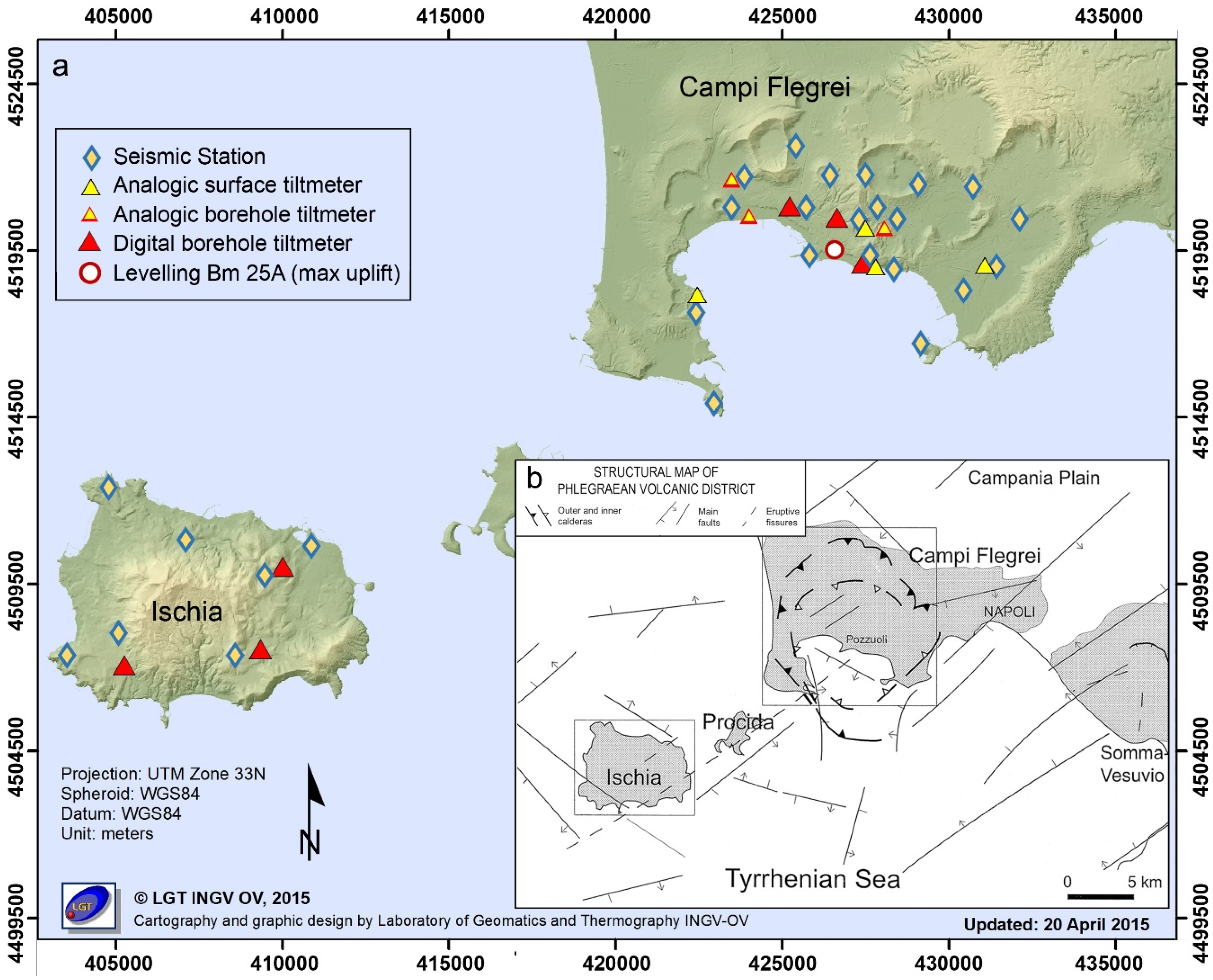
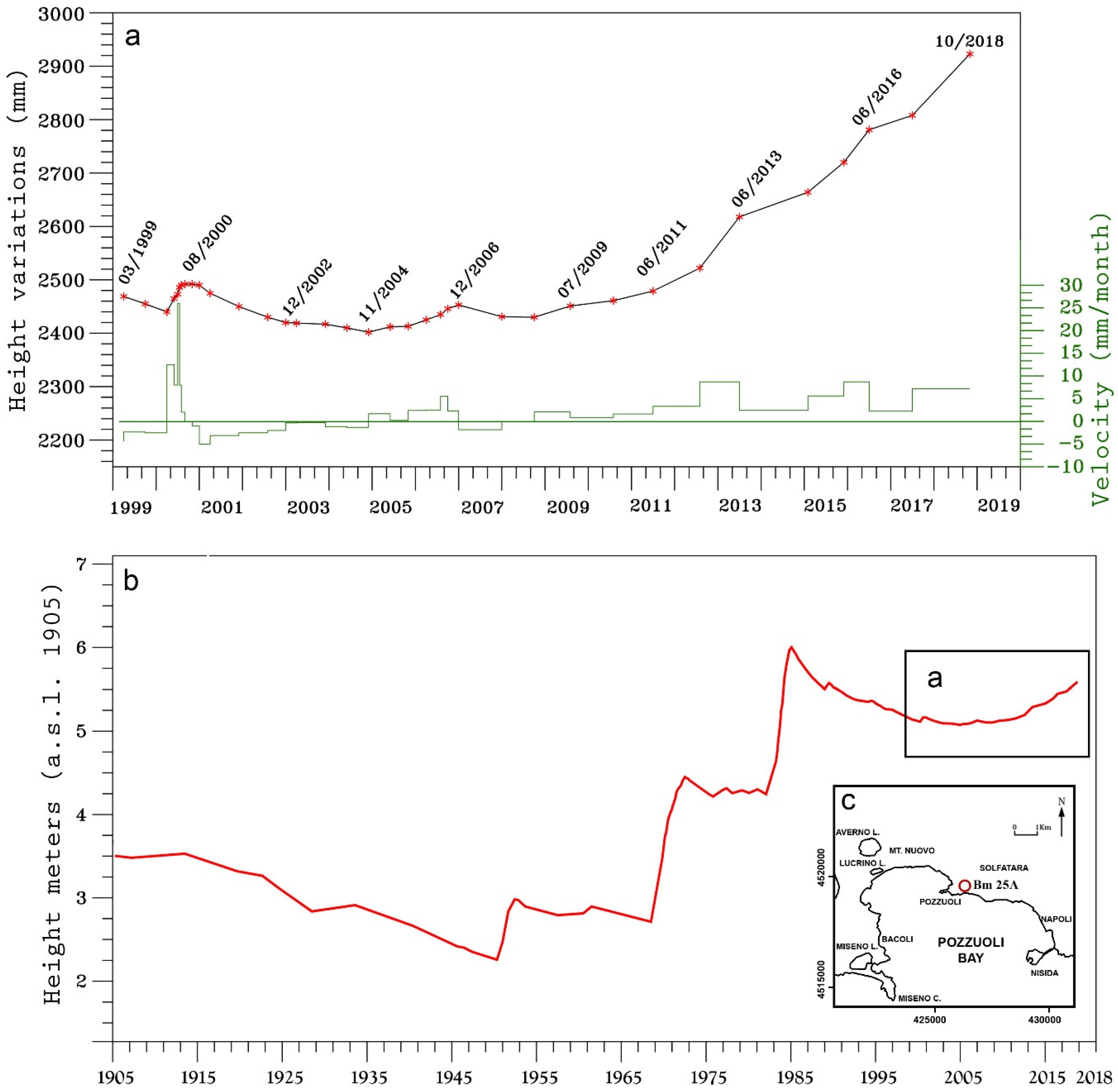
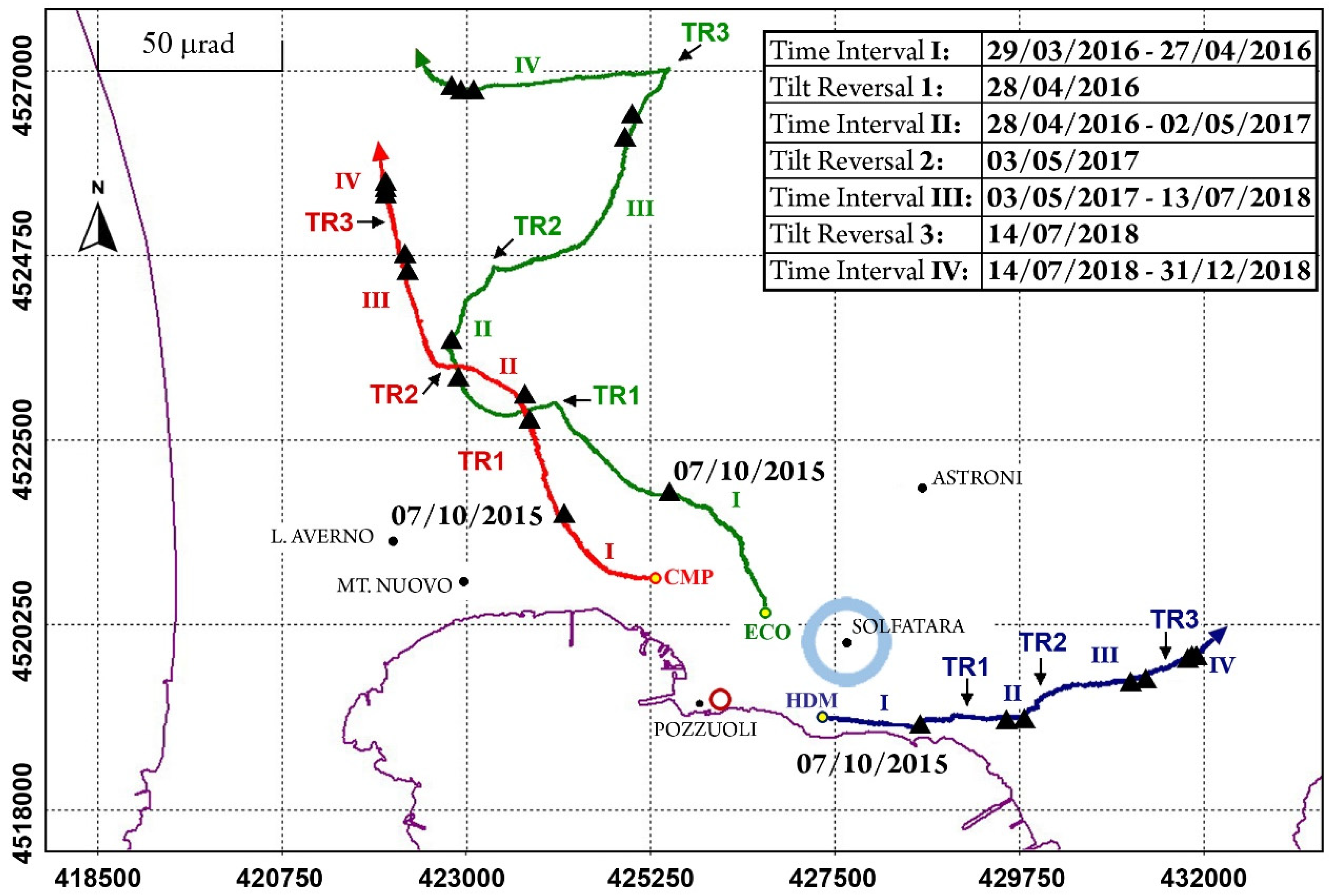
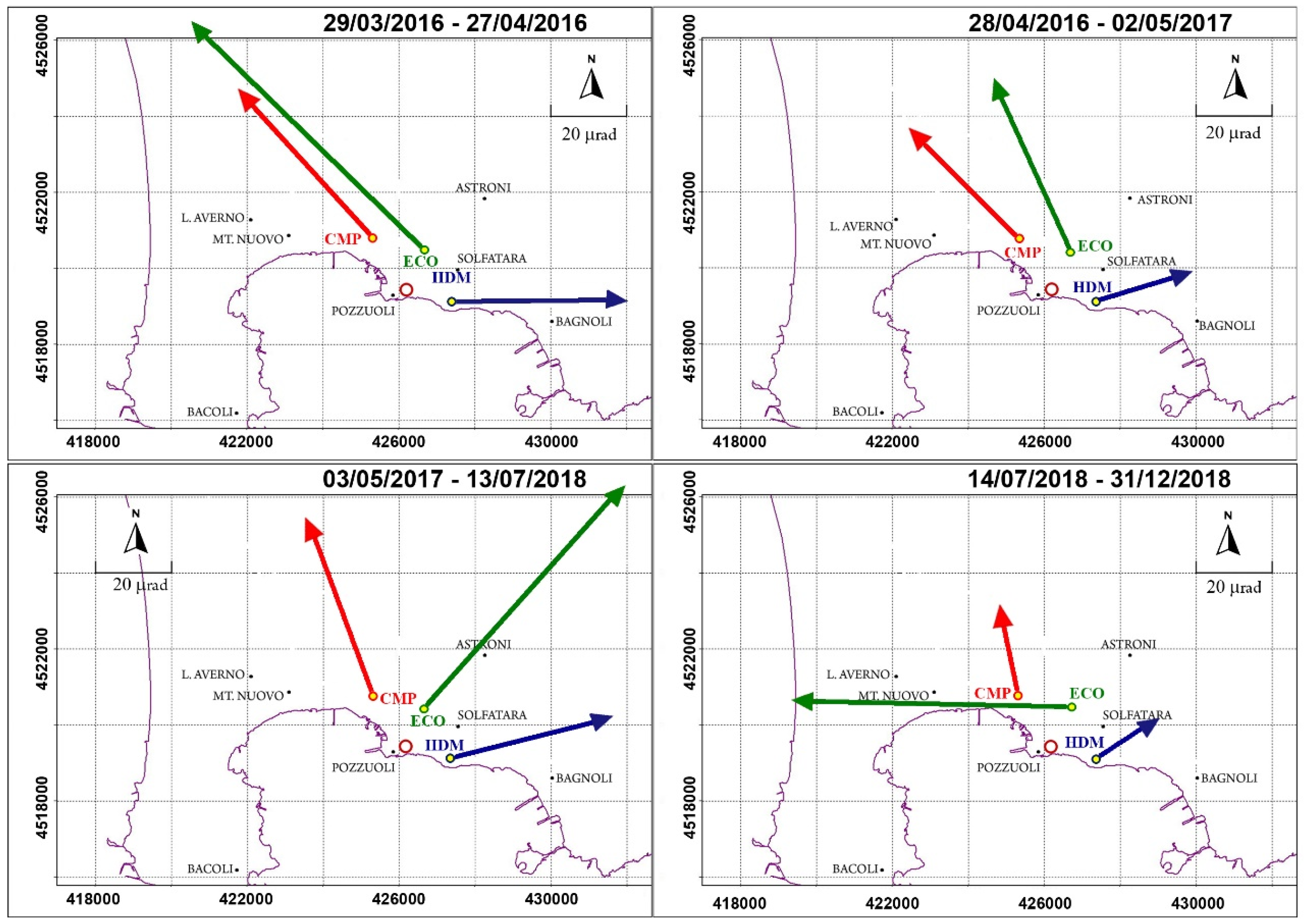
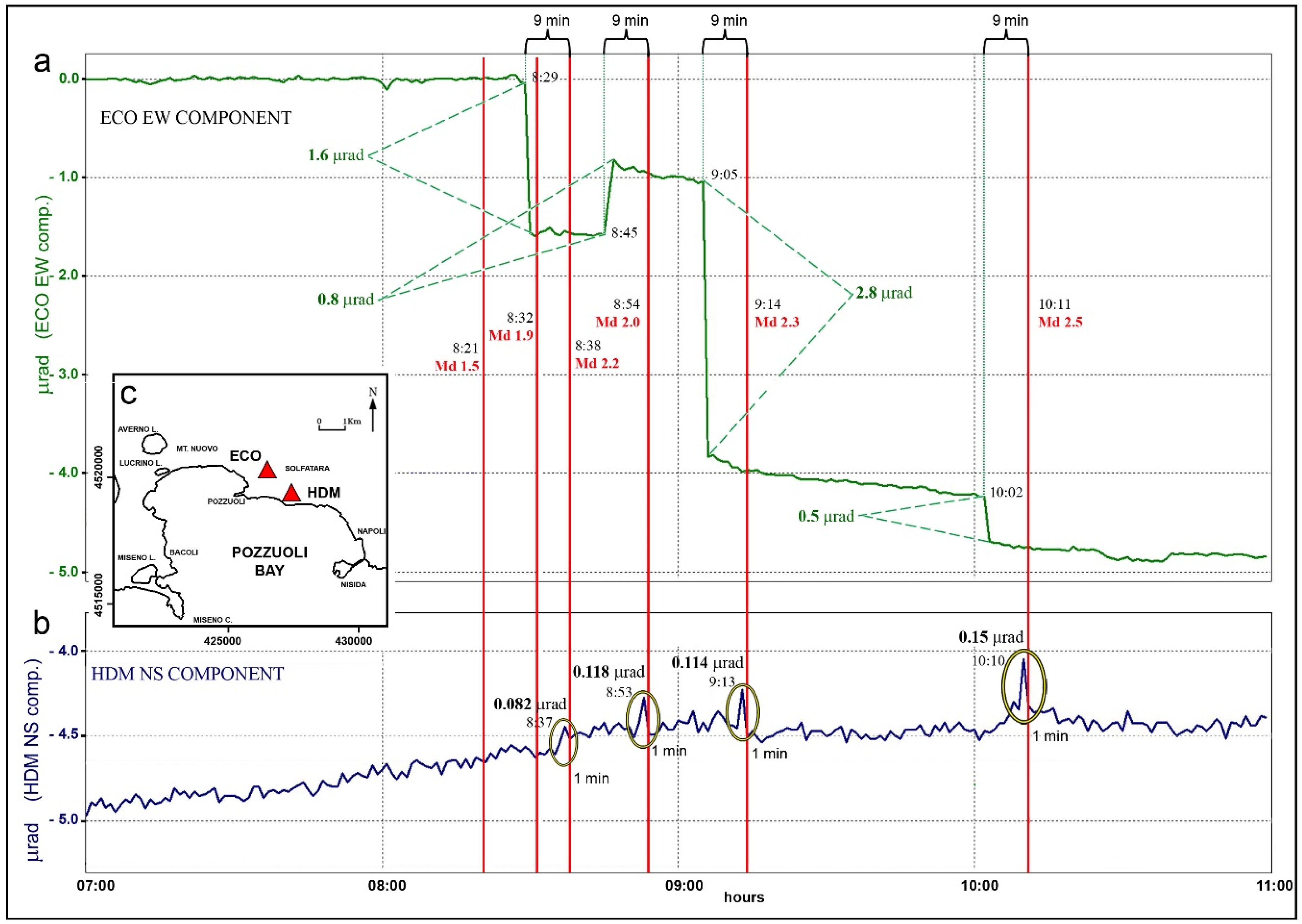
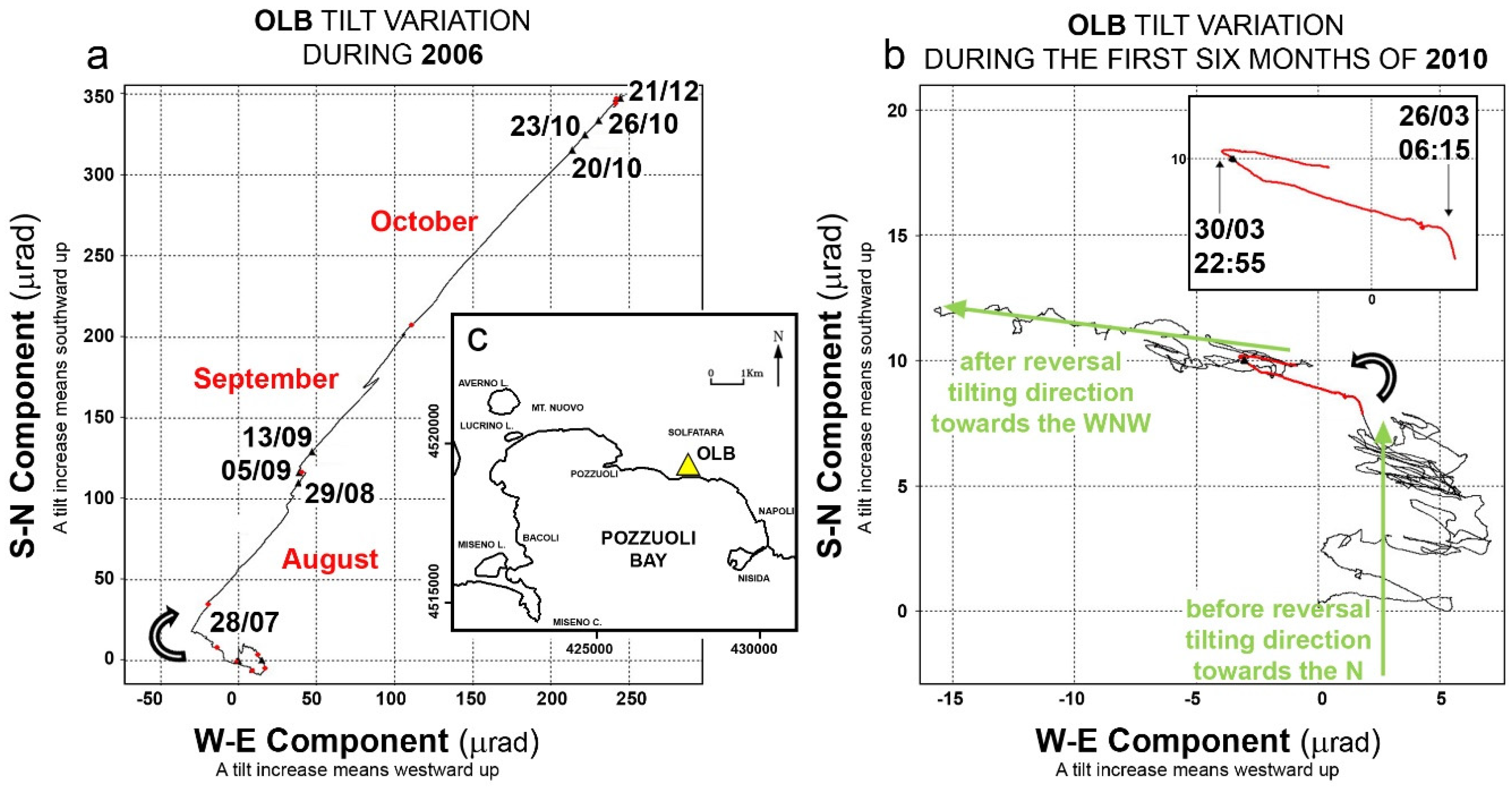
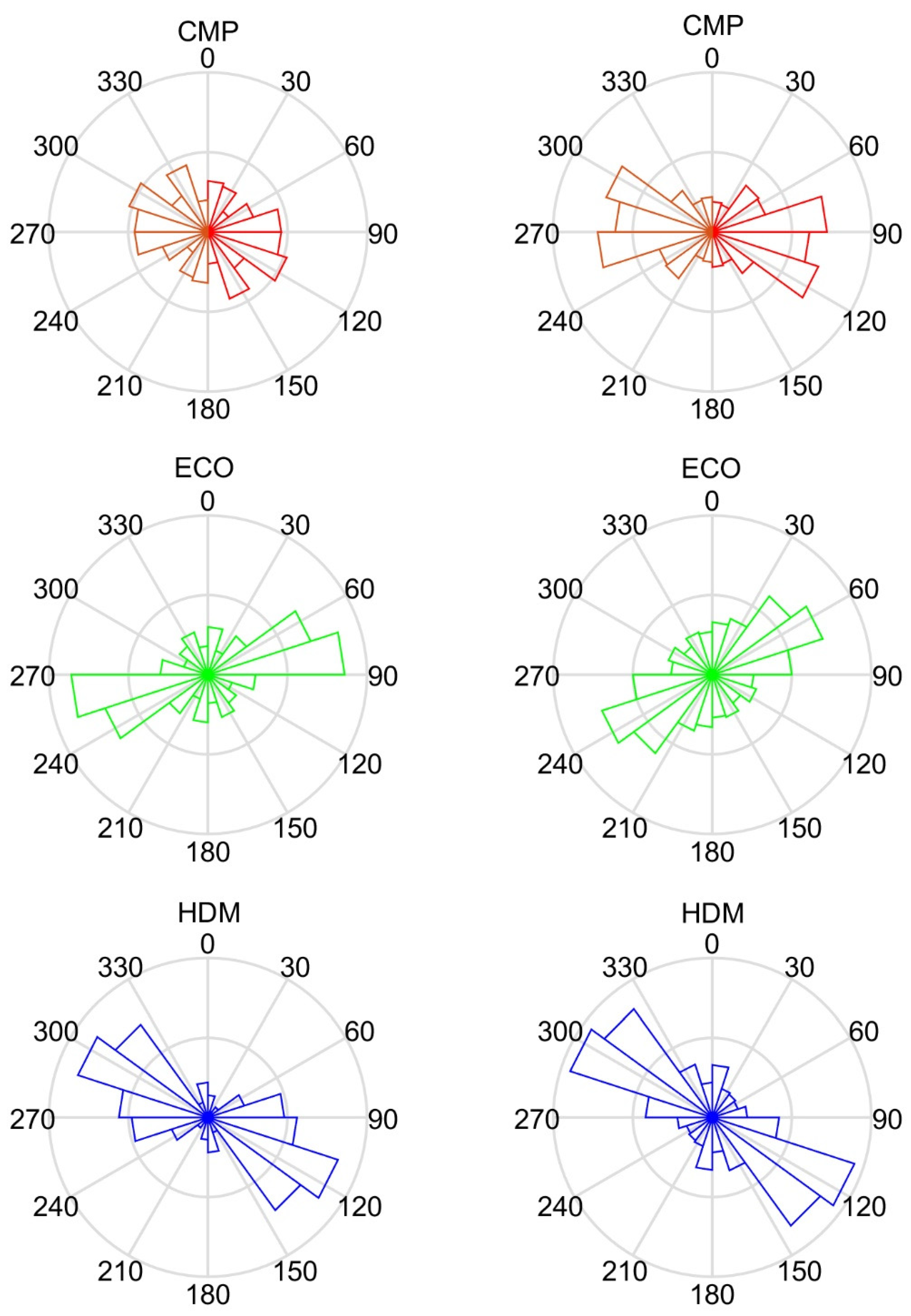
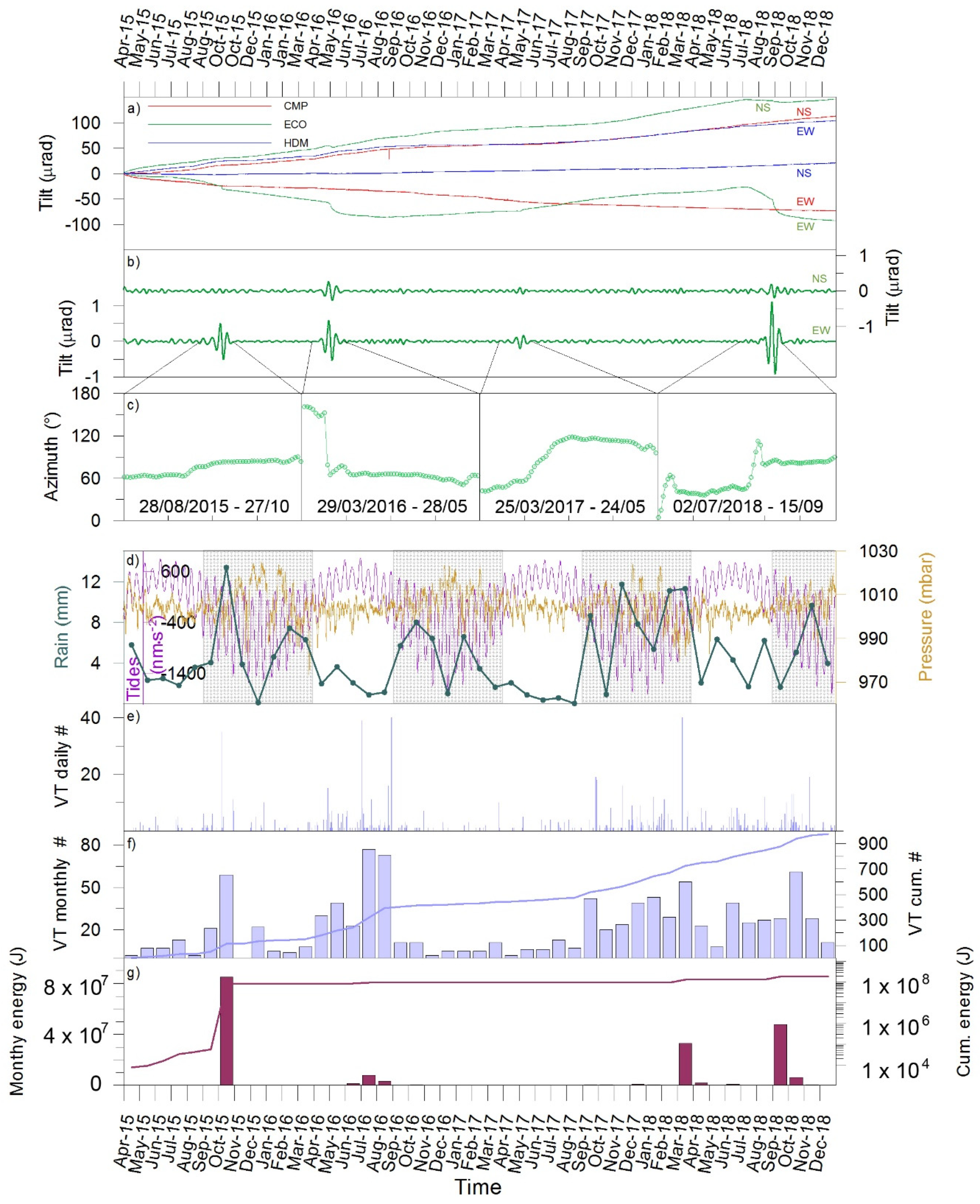
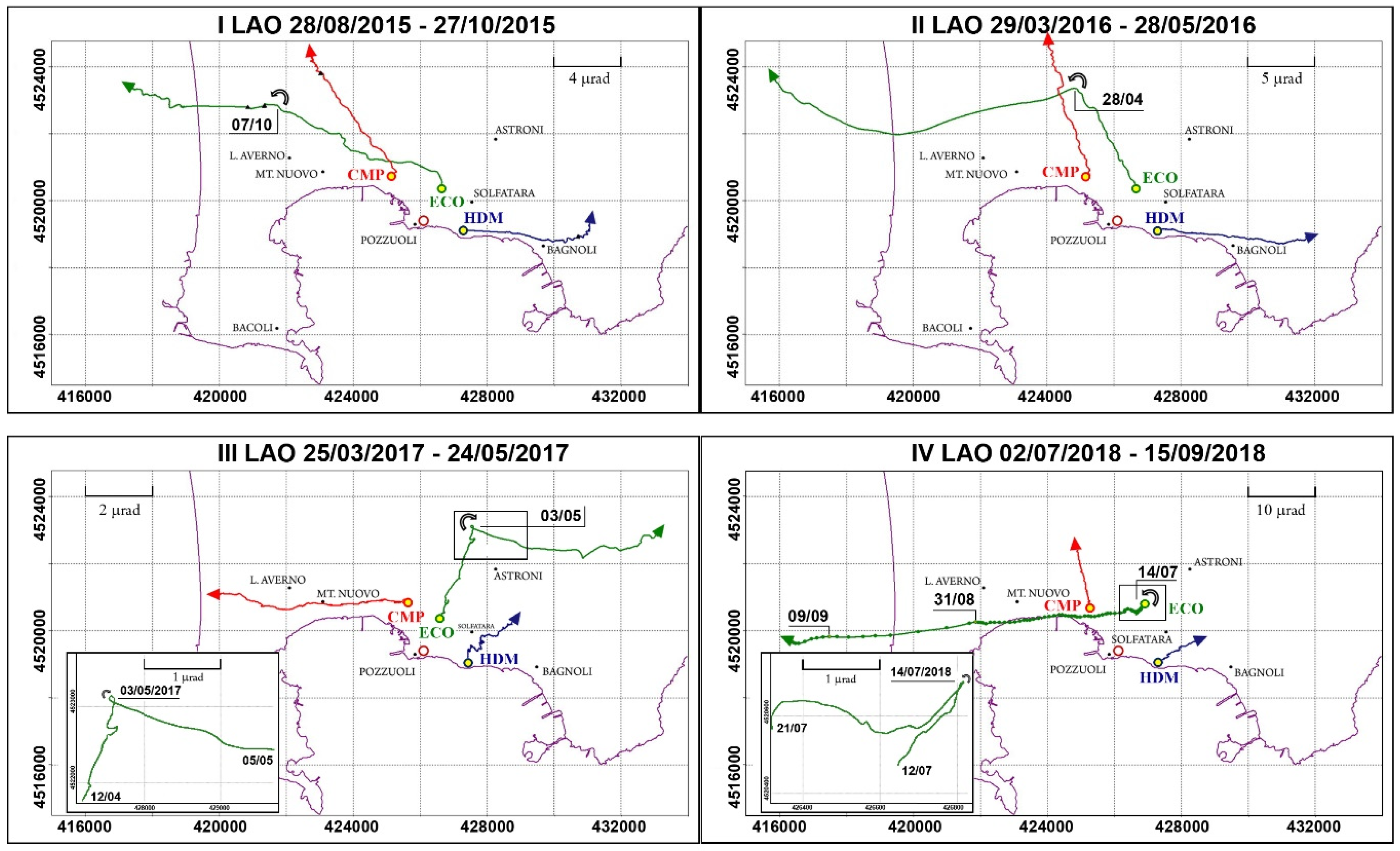
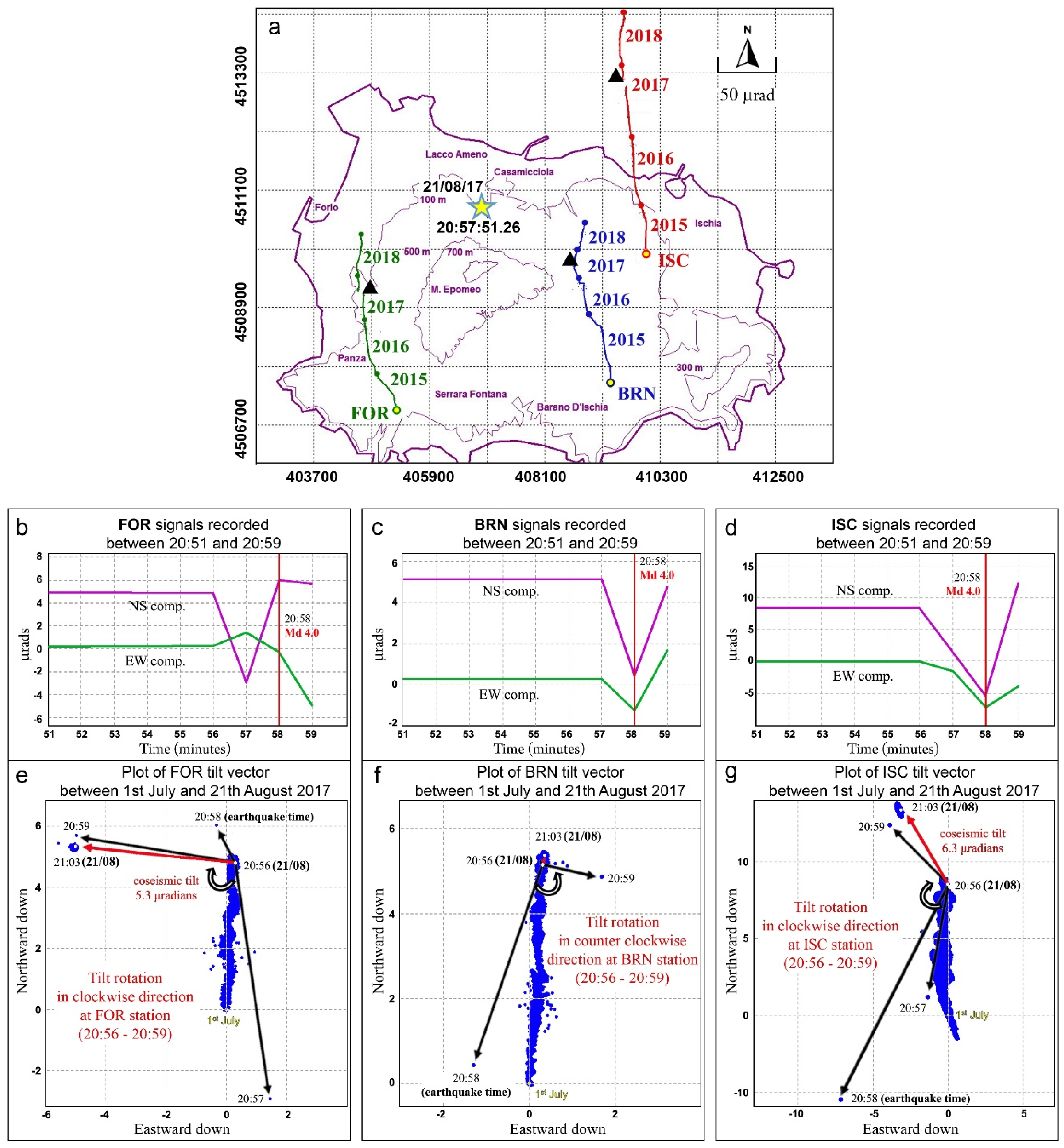
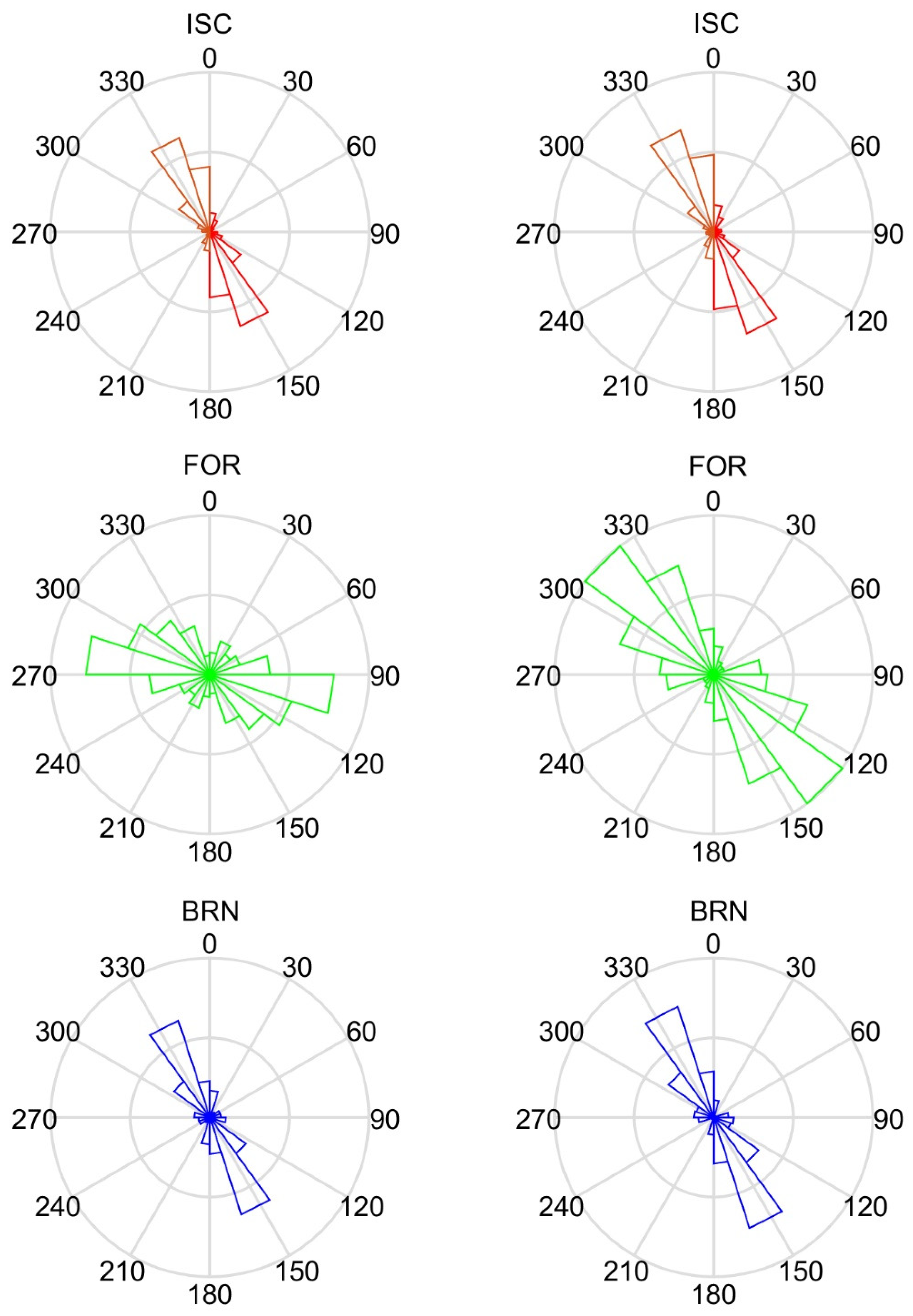
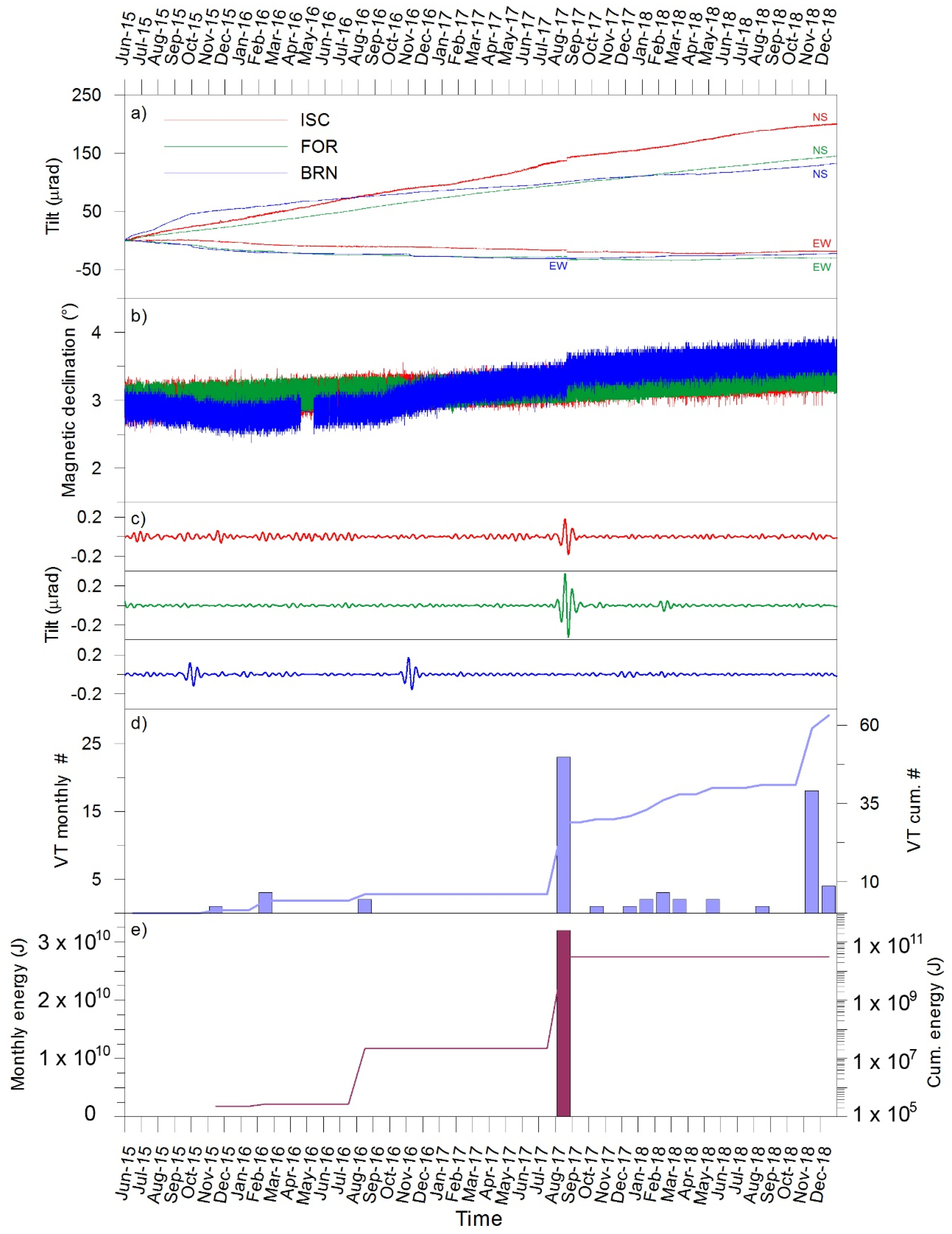
© 2019 by the authors. Licensee MDPI, Basel, Switzerland. This article is an open access article distributed under the terms and conditions of the Creative Commons Attribution (CC BY) license (http://creativecommons.org/licenses/by/4.0/).
Share and Cite
Ricco, C.; Petrosino, S.; Aquino, I.; Del Gaudio, C.; Falanga, M. Some Investigations on a Possible Relationship between Ground Deformation and Seismic Activity at Campi Flegrei and Ischia Volcanic Areas (Southern Italy). Geosciences 2019, 9, 222. https://doi.org/10.3390/geosciences9050222
Ricco C, Petrosino S, Aquino I, Del Gaudio C, Falanga M. Some Investigations on a Possible Relationship between Ground Deformation and Seismic Activity at Campi Flegrei and Ischia Volcanic Areas (Southern Italy). Geosciences. 2019; 9(5):222. https://doi.org/10.3390/geosciences9050222
Chicago/Turabian StyleRicco, Ciro, Simona Petrosino, Ida Aquino, Carlo Del Gaudio, and Mariarosaria Falanga. 2019. "Some Investigations on a Possible Relationship between Ground Deformation and Seismic Activity at Campi Flegrei and Ischia Volcanic Areas (Southern Italy)" Geosciences 9, no. 5: 222. https://doi.org/10.3390/geosciences9050222
APA StyleRicco, C., Petrosino, S., Aquino, I., Del Gaudio, C., & Falanga, M. (2019). Some Investigations on a Possible Relationship between Ground Deformation and Seismic Activity at Campi Flegrei and Ischia Volcanic Areas (Southern Italy). Geosciences, 9(5), 222. https://doi.org/10.3390/geosciences9050222




